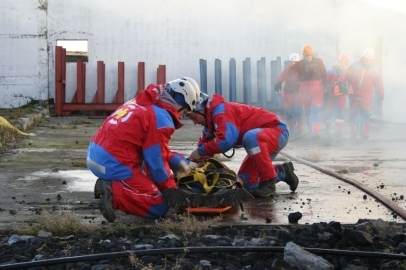From Ambassador
2019/2/27
Icelandic rescue teams


While being blessed with rich and beautiful nature, Iceland is no stranger to natural hazards. Throughout its history, Iceland has faced many disasters and accidents: volcanic eruptions, avalanches, people getting lost in snowy mountains, marine accidents and so forth. Consequently, search and rescue organizations have been uniquely developed in Iceland.
In 1918, about 100 year ago, fishermen‘s wives in the Westman Islands, worried about their husbands being buffeted by rough seas, came together and formed an aid association or a so-called rescue squad. Since then, similar unofficial organizations have been formed throughout the country.
These organizations merged and a national body called “ICE-SAR, Icelandic Association for Search and Rescue” was established in 1999. Currently, in most hazardous cases, ICE-SAR’s rescue teams take the initiative in conducting search and rescue operations.
What is special about ICE-SAR is that most of its 10,000 members, belonging to roughly 100 rescue teams nationwide, provide their services on a volunteer basis. Although these volunteers have another full-time job to attend to, around 4,000 members are always on standby in order to deal with over 1,200 emergency cases annually.
Last year, I had the opportunity to visit the ICE-SAR headquarter, where not only ICE-SAR, but also the National Police (quasi bodies), the Coast Guard, the Civil Aviation Authority’s outpost agency and others are stationed. This holistic structure enables related parties to discuss and decide on appropriate countermeasures promptly and call for the service of the nearest rescue teams in the case of disasters and accidents.
Though the members are on a volunteer basis, they are required to learn various first-aid treatments and special techniques. Furthermore, in order to become a leader, they have to undergo 2 years of rigorous training. Equipment and resources of ICE-SAR are comparable with those of the National Police and the Coast Guard. The ICE-SAR units own various types of specialized equipment such as boats, snowmobiles and helicopters. While 70% of their expenditure is funded by firework sales around the New Year’s Eve, 30% is financed by public donations and the sales of accessories such as key chains.
The rescue teams have also conducted rescue operations abroad. In the immediate aftermath of the Haiti earthquake in 2010, 36 Icelandic rescue members were dispatched and were among the first foreign rescue team to arrive on the scene.
For those who are traveling from Japan, and for us Japanese residents in Iceland, it is very important to plan carefully before travelling in order to minimize risk of accidents occurring. However, in case you encounter accidents, the rescue teams are the ones to count on. The emergency dial is 112 and a smartphone app is also available to inform ICE-SAR headquarter of your location automatically. I recommend you to install the app beforehand.
112 Iceland App https://safetravel.is/112-iceland-app
In 1918, about 100 year ago, fishermen‘s wives in the Westman Islands, worried about their husbands being buffeted by rough seas, came together and formed an aid association or a so-called rescue squad. Since then, similar unofficial organizations have been formed throughout the country.
These organizations merged and a national body called “ICE-SAR, Icelandic Association for Search and Rescue” was established in 1999. Currently, in most hazardous cases, ICE-SAR’s rescue teams take the initiative in conducting search and rescue operations.
What is special about ICE-SAR is that most of its 10,000 members, belonging to roughly 100 rescue teams nationwide, provide their services on a volunteer basis. Although these volunteers have another full-time job to attend to, around 4,000 members are always on standby in order to deal with over 1,200 emergency cases annually.
Last year, I had the opportunity to visit the ICE-SAR headquarter, where not only ICE-SAR, but also the National Police (quasi bodies), the Coast Guard, the Civil Aviation Authority’s outpost agency and others are stationed. This holistic structure enables related parties to discuss and decide on appropriate countermeasures promptly and call for the service of the nearest rescue teams in the case of disasters and accidents.
Though the members are on a volunteer basis, they are required to learn various first-aid treatments and special techniques. Furthermore, in order to become a leader, they have to undergo 2 years of rigorous training. Equipment and resources of ICE-SAR are comparable with those of the National Police and the Coast Guard. The ICE-SAR units own various types of specialized equipment such as boats, snowmobiles and helicopters. While 70% of their expenditure is funded by firework sales around the New Year’s Eve, 30% is financed by public donations and the sales of accessories such as key chains.
The rescue teams have also conducted rescue operations abroad. In the immediate aftermath of the Haiti earthquake in 2010, 36 Icelandic rescue members were dispatched and were among the first foreign rescue team to arrive on the scene.
For those who are traveling from Japan, and for us Japanese residents in Iceland, it is very important to plan carefully before travelling in order to minimize risk of accidents occurring. However, in case you encounter accidents, the rescue teams are the ones to count on. The emergency dial is 112 and a smartphone app is also available to inform ICE-SAR headquarter of your location automatically. I recommend you to install the app beforehand.
112 Iceland App https://safetravel.is/112-iceland-app
